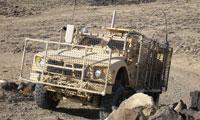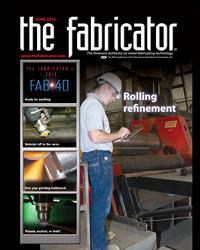- FMA
- The Fabricator
- FABTECH
- Canadian Metalworking
Categories
- Additive Manufacturing
- Aluminum Welding
- Arc Welding
- Assembly and Joining
- Automation and Robotics
- Bending and Forming
- Consumables
- Cutting and Weld Prep
- Electric Vehicles
- En Español
- Finishing
- Hydroforming
- Laser Cutting
- Laser Welding
- Machining
- Manufacturing Software
- Materials Handling
- Metals/Materials
- Oxyfuel Cutting
- Plasma Cutting
- Power Tools
- Punching and Other Holemaking
- Roll Forming
- Safety
- Sawing
- Shearing
- Shop Management
- Testing and Measuring
- Tube and Pipe Fabrication
- Tube and Pipe Production
- Waterjet Cutting
Industry Directory
Webcasts
Podcasts
FAB 40
Advertise
Subscribe
Account Login
Search
Nets to catch and protect
Webbing prevents RPGs from hitting vehicles, killing soldiers
- By Eric Lundin
- June 3, 2013
- Article
- Tube and Pipe Fabrication

Unpaved roads and treacherous terrain underscore the need for lightweight armoring systems. The Hindu Kush mountain range covers more than 60 percent of Afghanistan. The difference between the country’s highest and lowest points is 23,700 ft., double that of Iraq.
Bomber aircraft, nuclear-powered submarines, and aircraft carriers are among the most awe-inspiring and technologically advanced weapons delivery systems, but a weapon doesn’t have to be overwhelming to be deadly. Small, portable devices that combine lethal firepower with the ability to get close to targets undetected are just as threatening. Few are as fearsome as the rocket-propelled grenade (RPG). Initially developed during World War II as an anti-tank weapon, it is fired from a hand-held launcher, powered by an internal rocket motor, and stabilized by fins that deploy in flight.
They aren’t used just against tanks, but work against any sort of vehicle. Mine-resistant, ambush-protected (MRAP) vehicles are armored to withstand this threat, but armor has drawbacks. It increases the cost, weight, and fuel consumption and makes the vehicle slower and top-heavy, increasing the likelihood of a rollover.
Curbing the Weight
“Some of the original MRAP vehicles weigh 50,000 to 60,000 lbs. They are huge,” said Sloan MacKarvich, president of Industrial Laser Solutions, Atlanta, a fabricator that does some defense work. Using these in a region with paved roads and fairly flat topography, like much of Iraq, is one thing; using them in a mountainous region with poor roads, which describes most of Afghanistan, is something else altogether, MacKarvich explained. Even the sand in Afghanistan is a bigger hazard than the sand found in other regions.
“The sand is like quicksand,” he said. “They call it space dust.” A big vehicle would sink quickly, so the military needed lighter vehicles and something other than conventional armor to protect them.
One such system, developed by QinetiQ North America and named Q-Net™, traps the RPG in flight, preventing it from detonating. The system weighs little because it’s made from high-strength-to-weight materials—the netting is Kevlar®, and the frame is made from steel tube.
Industrial Laser Solutions cuts the tube to length, puts holes in it, bends it, and swages the ends. Much of the project involves run-of-the-mill tube bending, MacKarvich said, but the holes presented an interesting challenge.
“We got a little creative for this project,” he said. “We already were making some weldments for a similar project, so we were familiar with the system. Not only are the tubes rotary draw-bent, they are also swaged so that one end fits into the next. All the connection points have holes in them because they are pinned together, and the hole locations had to be held within 0.020 inch. This prevents the pins from clattering when the vehicle is going down the road.”
A competing supplier had the contract, but it couldn’t keep up with the demand. It machined the holes after the tube was swaged, but ILS figured it could make them faster by laser cutting the holes first, then tweaking the swaging process so it didn’t deform the hole as the tube end expanded.
“We eliminated postprocess machining and end trimming, which really cut the time it takes to produce them,” MacKarvich said.
Defeating the RPG
When an RPG strikes a stationary object, the impact depresses a plunger at the front of the weapon that ignites an internal fuse. The Q-Net system doesn’t stop the RPG; it is designed to disable it. It relies on a network of hard, sharp, pointed devices that damage the RPG.

Conventional passive armor consists of either steel plate or a lighter-weight alternative, a cage made from steel slats. QinetiQ North America devised a system that reduces the weight even further, a netting system fastened to a tubular framework.
“Features of the net actually tear into the RPG and break up the internal components,” said Don Steinman, vice president of technology solutions for QinetiQ North America. The net short-circuits the fuse, rendering the charge useless, Steinman explained.
The system can be installed in just a few hours. It bolts onto the hard points that military vehicles have for this sort of purpose, such as an external ammunition rack or water can holder, Steinman said. Mindful of soldiers’ needs, QinetiQ North America designed the Q-Net so it can be used in addition to other accessories, not instead of them.
How well does the netting work? According to “New net armor proves its worth,” an article posted at www.army.mil, the system was combat-tested in an incident shortly after being deployed in Ghazni Province in Afghanistan. Vehicles involved in this incident took three direct hits, and the netting snagged all of the RPGs, sparing all of the soldiers’ lives.
About the Author

Eric Lundin
2135 Point Blvd
Elgin, IL 60123
815-227-8262
Eric Lundin worked on The Tube & Pipe Journal from 2000 to 2022.
subscribe now

The Fabricator is North America's leading magazine for the metal forming and fabricating industry. The magazine delivers the news, technical articles, and case histories that enable fabricators to do their jobs more efficiently. The Fabricator has served the industry since 1970.
start your free subscription- Stay connected from anywhere

Easily access valuable industry resources now with full access to the digital edition of The Fabricator.

Easily access valuable industry resources now with full access to the digital edition of The Welder.

Easily access valuable industry resources now with full access to the digital edition of The Tube and Pipe Journal.
- Podcasting
- Podcast:
- The Fabricator Podcast
- Published:
- 04/16/2024
- Running Time:
- 63:29
In this episode of The Fabricator Podcast, Caleb Chamberlain, co-founder and CEO of OSH Cut, discusses his company’s...
- Industry Events
16th Annual Safety Conference
- April 30 - May 1, 2024
- Elgin,
Pipe and Tube Conference
- May 21 - 22, 2024
- Omaha, NE
World-Class Roll Forming Workshop
- June 5 - 6, 2024
- Louisville, KY
Advanced Laser Application Workshop
- June 25 - 27, 2024
- Novi, MI































